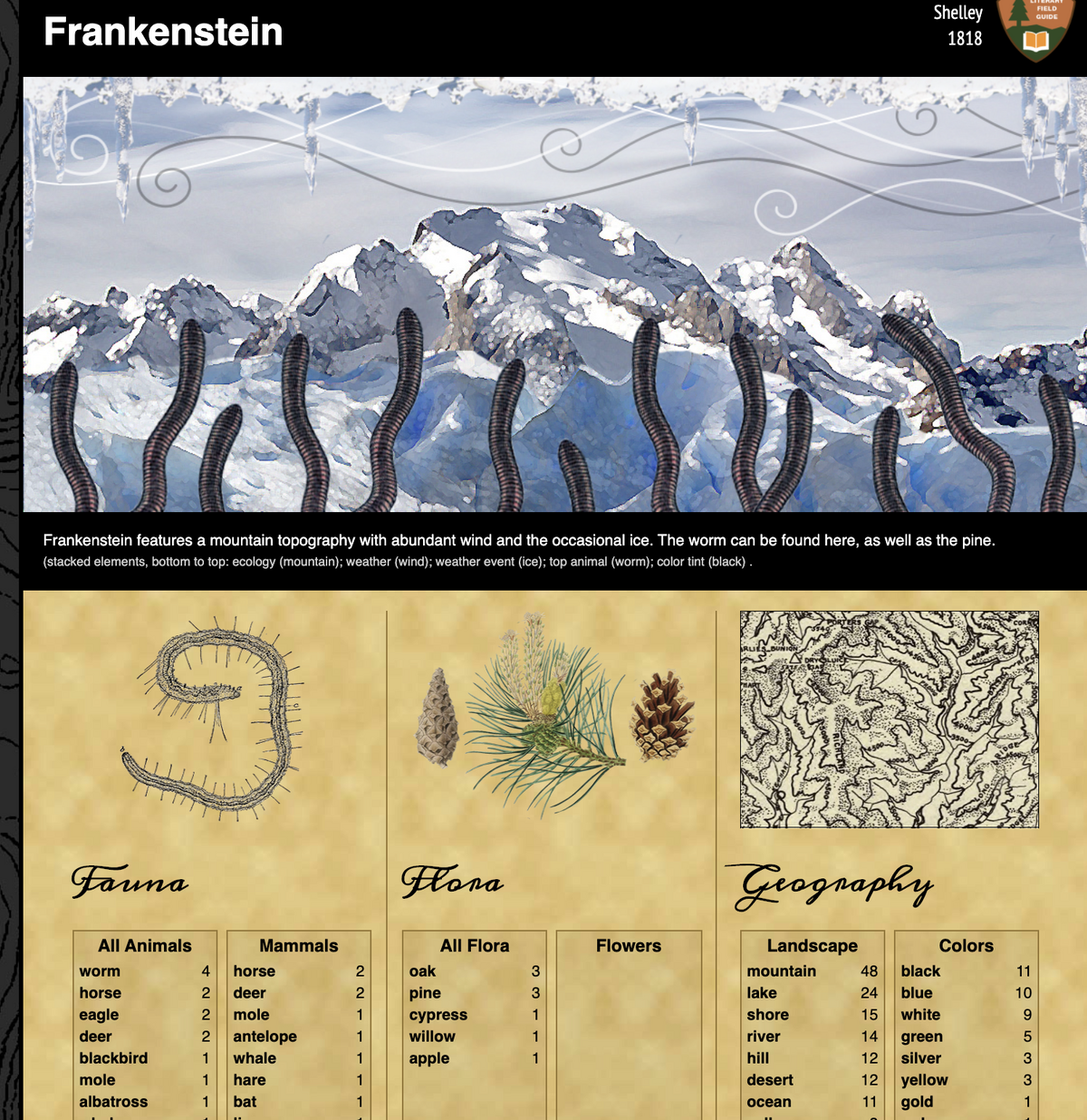Nature

Introduction
Given the increasingly disturbing realities of the climate change crisis, it is not surprising that literary studies have also expressed concerns about nature, and particularly species loss and habitat destruction. But this environmental awareness is often rooted in an idea of nature as the physical world seen in contrast to the human realms of culture, art, and civilization.
The Western philosophical framework for this dichotomy is the Greek understanding of nature or physis as the physical, as well as the origin and form or essence of a thing, distinguished from what has intention, or how a thing is used.
Literature, too, includes many variations on this philosophical framework, from an aesthetic of nature imitating art (or art for art's sake) to an ecological poetics that seeks to recreate nature's own language.
And what do digital methods bring to the understanding of this problem?
On the one hand, it may seem like a contradiction to analyse the vastness of the term “nature” and its many literary representations with advanced computer technologies; on the other hand, distant reading of large corpora allows for the identification of patterns and changes over longer periods of time and across geographical regions that a traditional approach to individual texts about nature and environment would not allow. In this way, digital methods contribute to a more nuanced, complex, comprehensive, and surprising understanding of nature.
Applications
Elementary
ThinkMap Visual Thesaurus is an online thesaurus and dictionary providing an interactive map that can be used to visually explore more than 150 000 words. The ThinkMap Visual Thesaurus can thus be used as a tool to explore the different possible constellations of terms and look up their associations in a visual manner, in this case looking at the associations of nature-related terms. Another yet similar approach is to look up hypernyms and hyponyms of the word nature in WordNet, a large lexical database that groups words into sets of synonyms in order to further understand word relations and groupings.
Voyant Tools also offer helpful tools for visualising the connections between words and how they change over time. For instance, it is possible to open the corpus of Shakespeare's plays in VoyantTools and use the search term 'Nature' in ScatterPlot or Links to visualise the connections and changes over time.
When considering the depiction of nature in literature from a broader perspective, it can be relevant to study the rising number of articles dealing with climate fiction or how ecocriticism has taken off. This can both be approached by compiling a corpus and by targeting particular kinds of journals relevant for literature such as JSTOR, Project MUSE, or DSH.
Advanced
Although literature has always reflected the changing relationship of humans and the natural world, and nature is an often-appearing symbol and metaphor, it was only in the 1990s that ecocriticism, the study of the significance of nature in literature, saw its rise to examine how nature is addressed in literature. Climate change in literary fiction allocates a new kind of agency to humans as planet changers, making threatening climate futures more tangible for the readers (Bina et al., 2017). These tendencies can also be detected through computational methods, as Lee’s findings imply (2021). However, computational investigation of cli-fi has not yet been widely applied.
Topic modeling, i.e. detecting word clusters and their distribution in a corpus, can be a fruitful way of exploring patterns in a literary genre. To explore the characteristics of climate change fiction, collect your corpus of cli-fi literature and other nature texts, and upload them to the topic modeler on Voyant Tools. The tool uses latent Dirichlet allocation (LDA) to go through the corpus and algorithmically assigns the most applicable words for each topic. Observe term coherences, and compare document differences to other nature writing texts. Alternatively, you can build your own topic model with the Dariah Topics package.
For further analysis, build your own vector space model (VSM) based on a corpus of your choice. In a VSM, words are represented as vectors. Based on co-occurrence, words that are similar in meaning also have vectors close to each other. This way, texts similar to each other can also be classified into different categories. Follow this guide to understand the methods and train your unsupervised machine classification model. Analyse the emerging topics and the classification performance. Is cli-fi a distinguishable genre from the computational point of view?
Resources
Scripts and sites
-
Dariah, A Library for Topic Modelling and Visualisation.
-
A Jupyter Notebook for Document Similarity.
-
Unsupervised machine learning tutorial for text classification.
-
Topic modelling guide in R with the tidy package by Julia Silge and David Robinson.
-
Voyant Tools, an analysis and visualisation environment for digital texts.
- Planet and Narration, a project by Cheryl Lousle.
- Literary Field Guide, a tool providing an overview of the textual ecology for an uploaded text.
Articles
-
Bina, O., Mateus, S., Pereira, L., & Caffa, A. (2017). The future imagined: Exploring fiction as a means of reflecting on today’s Grand Societal Challenges and tomorrow’s options. Futures, 86, (pp. 166-184). https://doi.org/10.1016/j.futures.2016.05.009
-
Lee, J. J., & Beckelhimer, J. (2020). Anthropocene and Empire: Discourse Networks of the Human Record. PMLA, 135(1), 110-129.https://doi.org/10.1632/pmla.2020.135.1.110
-
Lee, J. (2021, February 8). Opening the Athropocene Archives. Public Books. https://www.publicbooks.org/opening-the-anthropocene-archives/, accessed on 02.16.2021.
-
Piper, A. & Portelance, E. (2016, May) How Cultural Capital Works: Prizewinning Novels, Bestsellers, and the Time of Reading. Post45 https://post45.org/2016/05/how-cultural-capital-works-prizewinning-novels-bestsellers-and-the-time-of-reading
-
Posthumus, S., & Sinclair, S. (2014). Reading environment(s): digital humanities meets ecocriticism. Green Letters, 18(3), 254-273. https://doi.org/10.1080/14688417.2014.966737
- Turner, J. (2016, January 19). Another Extinction: Words We Use to Describe the Natural World - Our World. Our World. https://ourworld.unu.edu/en/another-extinction-words-we-use-to-describe-the-natural-world